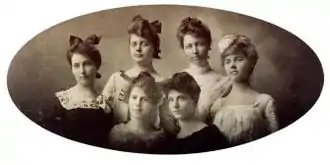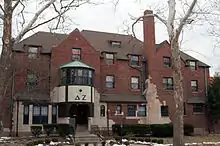Delta Zeta
Delta Zeta (ΔΖ, also known as DZ) is an international college sorority founded on October 24, 1902, at Miami University in Oxford, Ohio.
| Delta Zeta | |
|---|---|
| ΔΖ | |
 | |
| Founded | October 24, 1902 Miami University, (Oxford, Ohio) |
| Type | Social |
| Scope | International |
| Colors | Rose Green |
| Symbol | Roman Lamp |
| Flower | Pink Killarney Rose |
| Jewel | Diamond |
| Publication | The LAMP of Delta Zeta |
| Philanthropy | Speech and Hearing; The Painted Turtle, The Starkey Hearing Foundation |
| Chapters | 170 |
| Colonies | 5 |
| Members | 260,000 lifetime |
| Mascot | Turtle |
| Headquarters | 202 East Church Street Oxford, Ohio USA |
| Website | http://www.deltazeta.org |


Delta Zeta has 170 collegiate chapters in the United States and Canada, and over 200 alumnae chapters in Canada, the United Kingdom and the United States. As of 2013, there are over 244,400 college and alumnae members, making them the third largest sorority in the nation (after Alpha Delta Pi and Chi Omega).[1] In 1954, the sorority adopted speech and hearing as its philanthropic cause, and is partnered with the Starkey Hearing Foundation and Gallaudet University. Throughout its history, it has absorbed several other smaller sororities and also opened its first Canadian chapter in 1992.
Delta Zeta is one of 26 national sororities which are members under the umbrella organization of the National Panhellenic Conference; the sorority joined the Conference in 1910.
History
.jpg.webp)
Delta Zeta Sorority was founded at Miami University in Oxford, Ohio in 1902, the same year that the university first allowed female students.[2] Miami is dubbed the "Mother of Fraternities" because of the many prominent men's fraternities which were founded there.
Six of the newly admitted women consulted university president Dr. Guy Potter Benton regarding the founding of the first sorority chapter.[2][3] Having been a leader in the Phi Delta Theta fraternity, he was familiar with the processes of a Greek organization and helped the women establish the first Delta Zeta chapter, the first sorority at the campus. Benton aided in preparation of the ritual, badge, and colors. For his contributions, he was named the 'Grand Patron'. The Delta Zeta Sorority was officially incorporated on October 24, 1902. The founding members were: Alfa Lloyd Hayes, Mary Jane Collins, Anna Louise Keen, Julia Lawrence Bishop, Mabelle May Minton, and Anne Dial Simmons.[2]
The women were harassed for wanting to form a sorority. In one account, someone stole the constitution out of the secretary's hand but Dr. Benton pursued the offender and retrieved the constitution.
The first National Assembly, with Lloyd as the national president, was held in 1907.[4]
In 1910, Delta Zeta published the first issue of its national magazine, The LAMP, now issued three times a year.[4] That same year, the sorority joined the National Panhellenic Conference.[5]
Throughout the middle of the century, Delta Zeta absorbed four other sororities: Beta Phi Alpha in 1941, Phi Omega Pi in 1946, Delta Sigma Epsilon in 1956, and Theta Upsilon in 1962; most of these sororities had previously absorbed other, smaller sororities as well.[6][7]
In 1992, Delta Zeta chartered its first Canadian chapter at the University of Windsor, marking the beginning of the sorority's national expansion.[4]
Delta Zeta marked its Centennial Celebration in 2002.
Symbols
Delta Zeta's official flower is the pink Killarney rose, while the official stone is the diamond. The turtle is the official mascot. The Roman lamp is the official symbol.[8] The badge consists of a lamp on top of a winged Ionic column, all in gold, with a diamond set at the spout of the lamp and four pearls inset on the capital of the column.[9] The Greek letters are inscribed on the lamp. At its inception, the original badge did not include pearls, which were added a few years later.[4]
The sorority's official colors are rose and green.[8] The 1905 Baird's Manual lists the colors as "old rose and nile green" which some chapter websites used as of 2018.[10][11][9] The 1991 edition says "old rose and green". However, the official national web site lists the colors as "rose and green".[8]
Delta Zeta is one of the first sororities to have had a Lilly Pulitzer print made with its symbols.[4]
Philanthropy
Since 1954, the national philanthropy of Delta Zeta is speech and hearing. Part of the Delta Zeta creed states, "To those whom my life may touch in slight measure, may I give graciously of what is mine," in recognition of the importance of service. Delta Zeta has national partnerships with the Starkey Hearing Foundation and Gallaudet University. The sorority implements a "Heart For Hearing" to raise money for the foundation. Individual chapters may also support local organizations in their area.
In addition, Delta Zeta supports The Painted Turtle Camp as a national service project. This camp supports children with chronic and life-threatening illnesses. Delta Zeta is committed to supporting the camp financially through donations, as well as with their time through volunteering in the camp itself.
The Delta Zeta Foundation
The Delta Zeta Foundation is a not-for-profit entity within the organization that provides various scholarships for members of the sorority as well as funding leadership, philanthropy and education programs. There is a national philanthropic organization for active members of Delta Zeta known as the 1902 Loyalty Society, and members join by donating $19.02.[12]
Membership
Current National Council
The National Council of Delta Zeta is an alumnae board tasked with the governance of the organization.[13]
Notable alumnae

- Mercedes Bates (Chi) – first female corporate officer of General Mills Foods. After being appointed to head the Betty Crocker division, she was often referred to as "Betty Crocker".[14]
- Shelley Berkley (Iota Phi) – U.S. Representative for Nevada's 1st congressional district[15]
- Marti Dodson (Theta) – lead singer for national recording artist, Saving Jane[16]
- Nanette Fabray (Xi Omicron) – actress, worked to bring sign language and captioning to television[17]
- Tina Fey (Lambda Delta) – actress and director
- Edith Head (Alumna Initiate, Mu) – Emmy Award-winning designer; 7-time Oscar winner in costume design[18]
- Florence Henderson (Alumna Initiate, Alpha Chi – Honorary Member) – actress (The Brady Bunch)[19]
- Princess Märtha of Sweden (Alumna Initiate, Upsilon) – princess of Sweden, crown princess of Norway.[20]
- Maurine Brown Neuberger (Omega) – former US Senator[21]
- Melissa Ordway (Delta Delta) – actress and model
- Gail Patrick (Alpha Pi) — actress, executive producer of the Perry Mason television series; vice president of the first board of directors of the Delta Zeta Foundation; $1 million bequest established the Women of Distinction Program.[22][23]
- Ivy Baker Priest (Alpha Chi) – Former United States Treasurer[21]
- Pat Priest (Alpha Chi) – actress, (The Munsters)[21]
- Rebecca Rusch (Alpha Beta) - professional athlete [24]
- Galadriel Stineman (Kappa Beta) – actress[25]
- Marcia Wallace (Delta Nu) – TV and stage actress[26]
- Kay Yow (Zeta Lambda) – women's basketball Coach, NC State[27]
Collegiate chapters

Delta Zeta has 170 collegiate chapters in the United States and Canada and over 200 alumnae chapters in Canada, the United Kingdom, and the United States.[28]
Controversies
At the end of 2006, the Delta Chapter of Delta Zeta at DePauw University became enmeshed in a controversy that would eventually make national headlines and result in the chapter's closure.[29] The Delta Zeta national leadership was criticized after The New York Times published an article accusing the National office of moving certain members of the Delta Chapter at DePauw University to alumnae status based on their perceived attractiveness. Founded in 1909, the Delta chapter was the sorority's second oldest active chapter and its fourth oldest chapter overall (a "single letter" chapter). Despite its long history at DePauw, the Delta Zeta chapter struggled with declining membership and had acquired a negative reputation on campus. As a result, the Delta chapter members voted to request Delta Zeta Sorority to close the chapter due to falling numbers and lack of interest in recruitment. When notified of the chapter decision, Delta Zeta Sorority arranged a chapter membership review and chapter reorganization rather than close the chapter completely. Several of the members that were moved to alumnae status (and therefore required to move out of the Delta Zeta house at DePauw) argued that they were moved to alumnae status due to their perceived unattractiveness, weight, or ethnicity and contacted the media.[30]
Notes
References
- "Delta Zeta Sorority Selected to Colonize at University of Texas at Dallas (UTD)". Delta Zeta (press release). 18 November 2013. Archived from the original on 7 April 2014. Retrieved 4 April 2014.
- "Delta Zeta History". deltazeta.org. Archived from the original on 12 February 2016. Retrieved 21 October 2013.
- The Scroll of Phi Delta Theta. Phi Delta Theta Fraternity. 1912. pp. 131–132.
- "Delta Zeta History". Delta Zeta. 2015-04-01. Retrieved 2018-11-26.
- "Manual of Information" (PDF). National Panhellenic Conference. Jan 2018. Archived from the original (PDF) on 2018-06-18. Retrieved 2018-06-17.
- Becque, Fran (2015-03-02). "NPC Organizations That No Longer Exist; A Reflection on International Badge Day - Fraternity History & More". Fraternity History & More. Retrieved 2018-11-26.
- The Spring 1995 edition of The Lamp of Delta Zeta, p.10, has an article about the sorority's several mergers. Accessed 25 Aug 2020.
- "Delta Zeta Facts – Delta Zeta Sorority". Delta Zeta. Archived from the original on 2012-03-09. Retrieved 2012-06-10.
- "Delta Zeta - Panhellenic Association - Grand Valley State University". www.gvsu.edu. Archived from the original on 2018-11-26. Retrieved 2018-11-26.
- "History". Archived from the original on June 17, 2009. Retrieved June 12, 2008.
- "Delta Zeta Sorority | Epsilon Zeta Chapter". Archived from the original on May 11, 2008. Retrieved May 29, 2008.
- "1902 Loyalty Society". Delta Zeta. 2016-09-20. Retrieved 2018-10-03.
- "National Council". Delta Zeta. Archived from the original on 23 September 2015. Retrieved 1 September 2015.
- "Up Close and Personal: OSU's Connection to 'Betty Crocker'". OSU Alumni Association. Retrieved 2007-04-02.
- "Women of Achievement – Law, Government and the Military". Delta Zeta. Archived from the original on 2010-12-18. Retrieved 2012-02-17.
- "Spring 2006 – The Lamp of Delta Zeta" (PDF). Delta Zeta. Archived from the original (PDF) on 2007-09-27. Retrieved 2007-03-18.
- "Lamplighters host 50th Annual Flame Fantasy to Benefit the House Ear Institute". Delta Zeta. November 7, 2006. Retrieved 2007-03-18.
- "Delta Zeta Sorority – Edith Head". Delta Zeta. Archived from the original on 2007-09-27. Retrieved 2007-03-18.
- "Florence Henderson Official Site – FAQ". Florence Henderson Official Site. Archived from the original on 2000-01-19. Retrieved 2007-03-18.
- Brewer, Nancy, and Rochelle Mackey. A Century of Sisterhood: The Story of Delta Zeta Sorority 1902–2002. Phoenix: Heritage, Inc., AZ.
- "Famous Delta Zeta sisters". Tech Turtles of Delta Zeta. Archived from the original on 2007-03-11. Retrieved 2007-03-18.
- "Delta Zeta Sorority's Woman of the Year". Indiana Evening Gazette. October 27, 1962.
- "Gail Patrick Believed Delta Zeta Worthy of Major Bequest". Delta Zeta. Archived from the original on 2015-07-08. Retrieved 2015-07-07.
- "Spring/Summer2018". lamp.deltazeta.org. Retrieved 2018-12-05.
- Wheeler, Lauren (November 8, 2012). "EMB grad makes a name for herself in L.A." The Northerner (NKU). Retrieved January 29, 2016.
- "Spring 2005 – The Lamp of Delta Zeta" (PDF). Delta Zeta. Archived from the original (PDF) on 2007-09-27. Retrieved 2007-03-18.
- "Kay Yow ΖΛ '62, 1987 Delta Zeta Woman of the Year". Delta Zeta. October 8, 2007. Retrieved 2007-11-15.
- "Fast Facts". Delta Zeta. 2016-05-21. Retrieved 2018-11-26.
- "DePauw University severs ties with sorority/". MSNBC. Associated Press. March 12, 2007. Retrieved 20 October 2013.
- Dillon, Sam (February 25, 2007). "Sorority Evictions Raise Issue of Looks and Bias". The New York Times. Retrieved 20 October 2013.
External links
- Delta Zeta Official Website
- National Service Project: The Painted Turtle
- National Philanthropic Partner: The Starkey Hearing Foundation